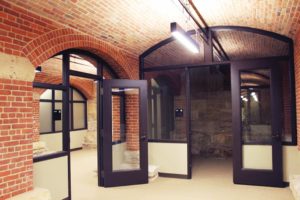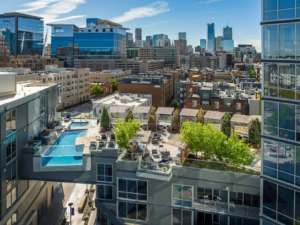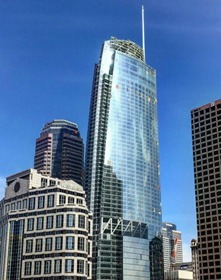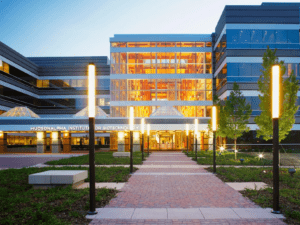Custom Steel Doors & Frames
Custom or In-Stock?
“What do you have in stock?” is something steel door distributors are hearing a little less these days. While there will always be demand for stock products, architects are increasingly choosing to customize – whether for sound resistant doors, opting for bullet resistant doors, or to add a modern touch with slim profile frames.
Custom steel doors and frames may be selected for a variety of reasons.
Unique Dimensions
Wouldn’t it be nice if every opening was a perfect 3’0” x 7’0”? That’s not reality though. Oversized and other nonstandard dimensions come up all the time in special use buildings and retrofits.
Enhanced Performance
Door assemblies can be upgraded for additional safety and comfort. They may offer protection from Mother Nature (e.g. hurricanes and tornadoes) or from people (e.g. acoustic doors, forced entry resistant doors, bullet resistant doors or blast doors). Generally, these look just like regular doors because the performance comes from the door core and hardware.
Aesthetics
Steel doors can have embossments or attractive panels. Some architects like to have millwork affixed to the trim or have a faux wood finish with woodgrain etching. There are countless ways to customize the appearance.
Custom steel doors and frames don’t have to be complicated. To pass along some ideas, here are recent custom projects completed by SDI Certified manufacturers.
De La Fontaine
Steelcraft
Deansteel
MPI
Ceco Door
Pioneer
DCI
Curries
Republic
Premier
De La Fontaine

 De La Fontaine was proud to be invited to work on renovations to the Illinois State Capitol Building located in Springfield, IL. The main portion of this building was constructed in the late 1870’s. The state wanted to renovate the basement area of the original building to accommodate many new needs and also provide access to a new parking structure. Also included in the project is a new visitors entrance which will allow screening of visitors before they gain entrance to the Capitol building.
De La Fontaine was proud to be invited to work on renovations to the Illinois State Capitol Building located in Springfield, IL. The main portion of this building was constructed in the late 1870’s. The state wanted to renovate the basement area of the original building to accommodate many new needs and also provide access to a new parking structure. Also included in the project is a new visitors entrance which will allow screening of visitors before they gain entrance to the Capitol building.
This project required some interesting custom hollow metal doors and frames. As you can see, there are lots of beautiful arches and arched doorways in the space. De La Fontaine was able to customize these openings with new steel doors while maintaining the historical appearance and significance.

Steelcraft
With that in mind, the architects were seeking doors and frames that could withstand the climate, while also looking attractive in such a prominent tourism building.
They ended up contracting with Steelcraft, based in Cincinnati, Ohio, to produce 160 steel doors and frames with an embossed wood finish that emulates a real wood look through an engraining process in the door panel. A mahogany finish was selected for its rich appearance. Being in a humid environment, the standard galvannealed material type was a perfect match along with the strength of steel for a lasting solution.
The doors and frames had exactly what they wanted: the warmth of wood and the strength of steel.
Deansteel
The doors were a variety of sizes depending on the opening. In order to accommodate the blast conditions, parts of the frames were reinforced with solid steel blocks – no 20 gauge found in these doors! Some of the doors were up to 2-1/2” thick, many of which even had vision lights of 84mm thick specialty glass. The glass was layered instead of one solid chunk to meet the stringent blast and bullet resistance requirements.
The engineers at the nuclear power plant could have obtained these doors from Europe or any number of places, but they chose an American manufacturer because they liked what they saw when they toured the facility. Three months later they received the products, exactly to spec.

MPI
Standard door frames aren’t compatible with ICF, so the manufacturer contacted MPI in Corbin, KY to produce a custom solution. MPI produced custom integrated frame assemblies that would hold tight to the foam forms. The walls were poured with concrete and their custom frames became a solid part of the wall that meet all fire procedures and other industry requirements.

Ceco Door


Nationals Park, home of the Washington Nationals baseball team, is the first LEED certified green stadium in the country. LEED certification was awarded because of the park’s water conserving plumbing fixtures and it’s the use of recycled materials in 20 percent of the park’s construction.
The over 700 steel-stiffened Medallion doors and 800 masonry S – series frames were used for the park’s construction. These steel doors were produced by Ceco Door. The doors and frames are made from recycled steel, which contributed to the LEED requirement usage of total building materials being made of 20 percent recycled materials.
The U.S. Army was breaking ground on a new Army Cyber Command facility that would draw together their operations, capability development, training, and education in one location. Due to the high security nature of cyber operations, this command facility required a variety of highly specialized door opening solutions.
Ceco Door provided several types of acoustical openings including STC 45 and STC 50 ratings that required different sound seals, thresholds and door bottoms to achieve the required sound performance for the highly classified rooms. Radio Frequency Shielding openings were also supplied to ensure sensitive information is contained. The RF Openings provided 40 decibels of shielding along with STC 50 acoustical ratings. Blast resistant doors were also provided on particular exterior openings to meet the Department of Defense specifications.
Even though requirements on this project meant that some openings would require multiple performance attributes, Ceco was able to supply the variety of specialty openings that the Army needed to successfully complete the project.

Pioneer
 In January 2015, ground broke in downtown Denver on a new high rise called The Confluence. Fast forward three years, and a new 34 story tower of luxury apartments now graces the Denver skyline. The building boasts 288 units of studios, one, two, and three bedroom apartments that are available for $1,500 to $12,000 per month.
In January 2015, ground broke in downtown Denver on a new high rise called The Confluence. Fast forward three years, and a new 34 story tower of luxury apartments now graces the Denver skyline. The building boasts 288 units of studios, one, two, and three bedroom apartments that are available for $1,500 to $12,000 per month.
A prominent door distributor in the Midwest, along with a local wholesaler, partnered with Pioneer Door to manufacture 700+ steel door frames of varying heights, widths, and depths. But there was a catch… isn’t there always? They wanted the frames to be made without returns and welded together to allow for millwork trim to be affixed to the frames.
Not only did Pioneer produce the custom frames and millwork on time, they adjusted their production schedule to make the logistics feasible for frame installation at The Confluence.

DCI

 Construction was underway in the heart of downtown Los Angeles on what would become the tallest building in the West Coast. The project took immense logistical creativity due to the density of the location and the structure’s expansive footprint on the property. There were only a couple of loading docks and a perennial line of trucks waiting to drop off their materials, and without a convenient place for them to be stored.
Construction was underway in the heart of downtown Los Angeles on what would become the tallest building in the West Coast. The project took immense logistical creativity due to the density of the location and the structure’s expansive footprint on the property. There were only a couple of loading docks and a perennial line of trucks waiting to drop off their materials, and without a convenient place for them to be stored.
The building required custom glazed elevations and thousands of standard, fire rated, and custom hollow metal doors and frames. Due to the lack of storage space, the GC was dreading having to manage and catalogue all of the products.
In light of this, the manufacturer, DCI Hollow Metal on Demand, offered to deliver the products in smaller batches as needed. They would deliver 50 one day, another batch the next, etc. so the GC could install them as received rather than manage thousands of doors and frames on site. While the products were on time and made to spec, it was the custom delivery schedule that saved the day.

Curries

 The newly built HudsonAlpha Institute for Biotechnology in Huntsville, Alabama is home to a number of companies conducting cutting-edge research. The discoveries made within the institute’s walls are closely guarded and could hold the key to future success for these companies. Tenants need to be confident that they are working in a secure facility that will keep proprietary information safe within its confines.
The newly built HudsonAlpha Institute for Biotechnology in Huntsville, Alabama is home to a number of companies conducting cutting-edge research. The discoveries made within the institute’s walls are closely guarded and could hold the key to future success for these companies. Tenants need to be confident that they are working in a secure facility that will keep proprietary information safe within its confines.
HudsonAlpha was able to provide this high level of security with a broad range of products from ASSA ABLOY. The four-story building (270,000 sq. ft.) will house up to 900 employees and contains state-of-the-art laboratories for genomic research and development of products and services supporting genome-based medicine. The approximately 1,000 doorways in the building have been equipped with products from Curries. In addition, the locking hardware was supplied with MicroShield antimicrobial coating and all electromechanical openings were wired with ElectroLynx connectors, a unique ASSA ABLOY solution that simplifies installation and reduces costs.
Curries supplied more than 350 blast resistant openings to meet the required code standards of this project. The specialty doors were constructed to withstand from 12 psi to 34 psi of peak pressure to provide extra protection against explosions and excessive force.
In addition to needing the over 350 blast resistant openings on the project, the Navy also required the doors and frames to be delivered on a very strict and short schedule. To meet the challenge, Curries provided a shipping schedule that the distributor and contractor were able to work with to meet the Navy’s demands.
Republic
Their facilities organization was interested in acoustic doors that would limit the transmission of sound throughout the building. In addition to patient privacy, this would also comfort patients from the constant sounds of pacing personnel, noisy carts, and beeping machines.
HopeHealth ended up purchasing the acoustic doors from Republic Doors and Frames in McKenzie, TN. They produced doors with a variety of STC levels to suite the various openings, each with the necessary seals, door bottoms and thresholds to achieve the desired sound performance.
Premier
In 2010, an ambitious developer purchased the property to convert it into 1.1 million square feet of retail, offices, and residences – the city’s largest adaptive reuse project ever.
As you can imagine, the 85-year-old building was full of unique wall thicknesses, dimensions, and jamb depths. When it was all said and done, the developer purchased more than 500 doors in various sizes and styles, including custom 8’0” tall entry doors and frames. The doors were manufactured by Premier, who made them on a floor-by-floor basis to simplify storage during construction.
As you can see, there are countless ways to customize a door. Some architects are surprised by how easy it is to go custom. Steel door and frame manufacturers have the benefit of being able to use lasers and shears to size sheet metal to spec very efficiently.
The next time you’re wondering what’s in stock, consider if it’s worth going custom instead. Whatever customization you choose, consult with the manufacturer early in the process—they’ve seen it all and can be very helpful in the design process.
Resources
SDI has developed these resources for architects, specifiers and distributors on custom doors and frames.











